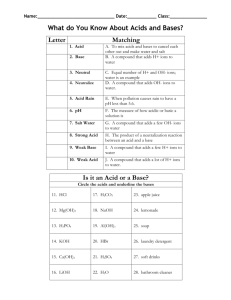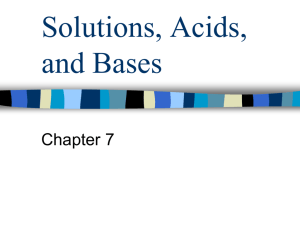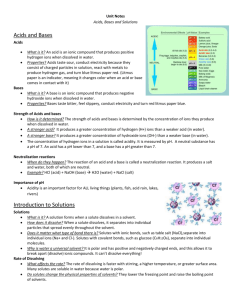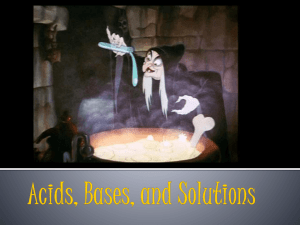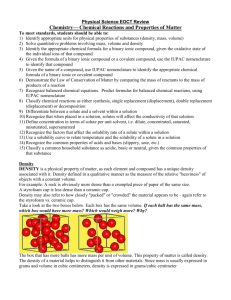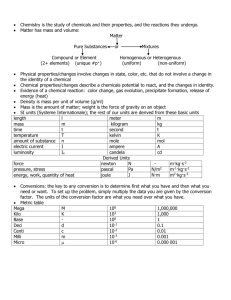EOCT Review Part 3
advertisement
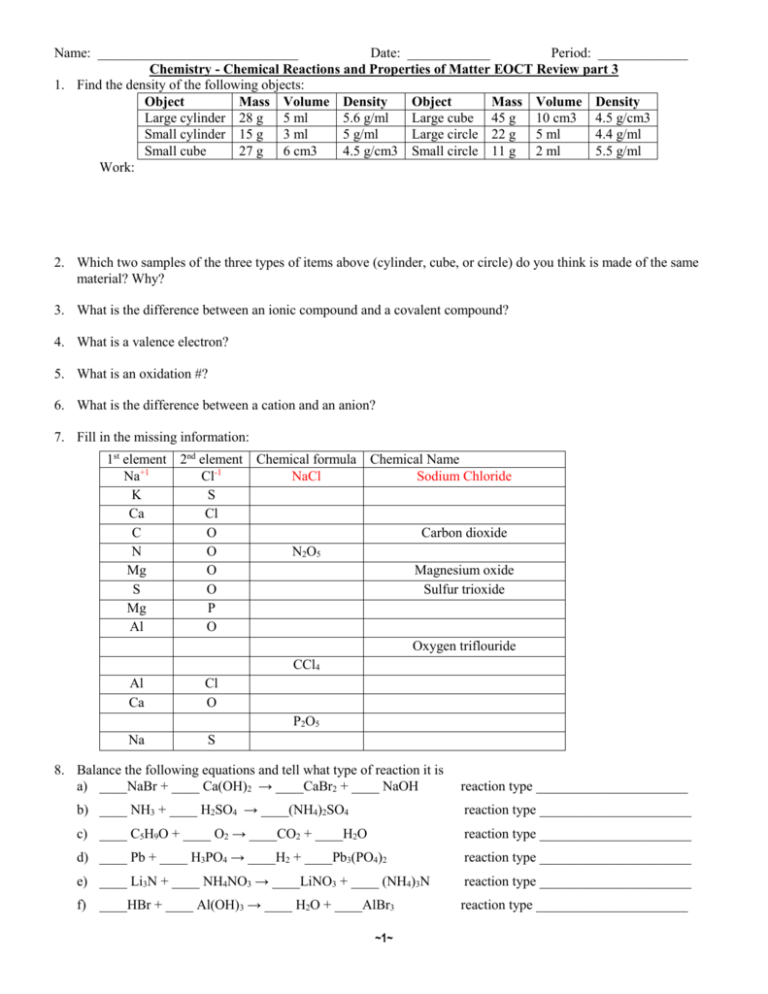
Name: _____________________________ Date: ____________ Period: _____________ Chemistry - Chemical Reactions and Properties of Matter EOCT Review part 3 1. Find the density of the following objects: Object Mass Volume Density Object Mass Volume Density Large cylinder 28 g 5 ml 5.6 g/ml Large cube 45 g 10 cm3 4.5 g/cm3 Small cylinder 15 g 3 ml 5 g/ml Large circle 22 g 5 ml 4.4 g/ml Small cube 27 g 6 cm3 4.5 g/cm3 Small circle 11 g 2 ml 5.5 g/ml Work: 2. Which two samples of the three types of items above (cylinder, cube, or circle) do you think is made of the same material? Why? 3. What is the difference between an ionic compound and a covalent compound? 4. What is a valence electron? 5. What is an oxidation #? 6. What is the difference between a cation and an anion? 7. Fill in the missing information: 1st element 2nd element Chemical formula Chemical Name Na+1 Cl-1 NaCl Sodium Chloride K S Ca Cl C O Carbon dioxide N O N2O5 Mg O Magnesium oxide S O Sulfur trioxide Mg P Al O Oxygen triflouride CCl4 Al Cl Ca O P2O5 Na S 8. Balance the following equations and tell what type of reaction it is a) ____NaBr + ____ Ca(OH)2 → ____CaBr2 + ____ NaOH reaction type ______________________ b) ____ NH3 + ____ H2SO4 → ____(NH4)2SO4 reaction type ______________________ c) ____ C5H9O + ____ O2 → ____CO2 + ____H2O reaction type ______________________ d) ____ Pb + ____ H3PO4 → ____H2 + ____Pb3(PO4)2 reaction type ______________________ e) ____ Li3N + ____ NH4NO3 → ____LiNO3 + ____ (NH4)3N reaction type ______________________ f) ____HBr + ____ Al(OH)3 → ____ H2O + ____AlBr3 reaction type ______________________ ~1~ Classify the following chemical reactions 1. C4H8 + 6O2 ---> 4CO2 + 4H2O 2. HCl + NaOH ---> H2O + NaCl 3. 2KNO3(s) ---> 2KNO2(s) + O2(g) 4. AgNO3 + NaCl ---> NaNO3 + AgCl 5. 2Mg + O2 ---> 2MgO 6. 2Ag + S ---> Ag2S 7. MgCO3(s) ---> MgO(s) + CO2(g) 8. Cl2 + 2KBr ---> 2KCl + Br2 9. In the following examples identify the solute and the solvent. a) Sugar dissolved in water - solute _________________ solvent ___________________ b) Salt dissolved in water - solute _________________ solvent ___________________ c) Carbon dioxide in soda - solute _________________ solvent ___________________ 10. What are the three things that will increase the rate of solubility of a solid in a liquid? 11. What are the two things that will increase the rate of solubility of a gas into a liquid? 12. List 3 properties specific to acids: a) b) c) 13. List 3 properties specific to bases: a) b) c) 14. List 2 properties that acids and bases share: a) b) 15. Explain what happens when an acid neutralizes a base. 16. Indicate whether the following substances are strong acids, weak acids, neutral, weak bases, or strong bases based on their pH. a) __________ Baking soda pH = 8 e) __________ Lye pH = 13 b) __________ Liquid plumber pH = 12 f) __________ Ajax liquid pH = 7.8 c) __________ Pepsi pH = 2.6 g) __________ Nail polish Remover pH = 6.5 d) __________ Pickle juice pH = 5 h) __________ Purified water pH = 7 ~2~ 2. 3. 4. 5. 1. 2. 3. 4. 5. 1. 2. 3. 4. 5. 6. 1. 2. 3. 4. 5. a. Chemistry Vocabulary Matching 1. Weak acid When pollution causes rain to be acidic (pH of less than 5.6). Neutral b. To mix acids and bases to cancel each other out and make salt and water. Acid rain c. Equal number of H+ and OH– ions; water is an example. Acid d. A compound that adds OH– ions to Base water. e. A compound that adds H+ ions to water. a. The largest natural element. Fuel for Alpha fission reactors. Particle b. Can be stopped by wood; occurs when Gamma a neutron breaks into a proton and Ray electron. c. An atom that emits energy or a Beta particle. Particle d. A helium nucleus (2 protons and 2 Radioactive neutrons); low in energy. Uranium e. Powerful radiation that can cause biological damage; takes many feet of concrete to stop. a. When a substance cannot be dissolved Solution into a solution. Alloy b. A mixture of two metals. c. A mixture that is homogeneous at the Dissolve molecular level. Suspension d. When something seems to disappears into a solution. Colloid e. A mixture that scatters light and the particles do not settle out. Insoluble f. A temporary mixture; the particles will settle into layers. a. A negatively charged ion: non-metals Ion b. A positively or negatively charged Cation atom because electrons have been gained or lost Anion c. An atom with the same number of protons and electrons Neutral d. Says the atoms will gain, loses, or Octet Rule share electrons in order to have 8 valance electrons e. A positively charged ion: metals Identify as Acid, Base, or Neutral 1. Neutralize _______ pH below 7 ______ pH above 7 _______ pH of 7 ______ taste bitter _______ taste sour ______ feels slippery _______ pure water _______ lemon juice _______ bleach _______ hydrogen acceptor _______ produces OH-1 _______ hydrogen donor 2. pH a. b. 3. Strong Acid c. 4. Salt Water d. 5. Weak Base e. 1. Chain reaction a. 2. Fission b. 3. Fusion c. d. 4. Half-life 5. Carbon Dating e. a. 1. Supersaturated b. 2. Saturated c. 3. Unsaturated 4. Solute 5. Solvent d. e. The measure of acids and bases. The product of a neutralization reaction between an acid and a base. A compound that adds a few H+ ions to water. A compound that adds a lot of H+ ions to water. A compound that adds a few OH– ions to water. Combining smaller atoms into larger atoms. Splitting large atoms into smaller ones. Toxic by-products. When one fission causes another and another, etc… Using the known decay of an isotope to determine the age of objects. The time necessary for 50% of a radioactive sample to decay. When a solution can hold more solute. When a solution can’t hold more solute. When a solution has more solute than it can hold. The part of a solution that is biggest. (The water in salt water.) The part of a solution that is smallest. (The salt is salt water.) Draw Lewis diagram for following elements: Calcium Oxygen Silicon Indium Give Valance Electrons for: Lithium ___ Nitrogen ___ Chlorine ___ Calcium ___ Phosphorous ____ Aluminum _____ Selenium _____ Give oxidation number (charge) for: Lithium ___ _______ produces H+1 Nitrogen ___ Chlorine ___ Calcium ___ Phosphorous ____ Aluminum _____ Selenium _____ _______ equal # of H+1 and OH~3~

